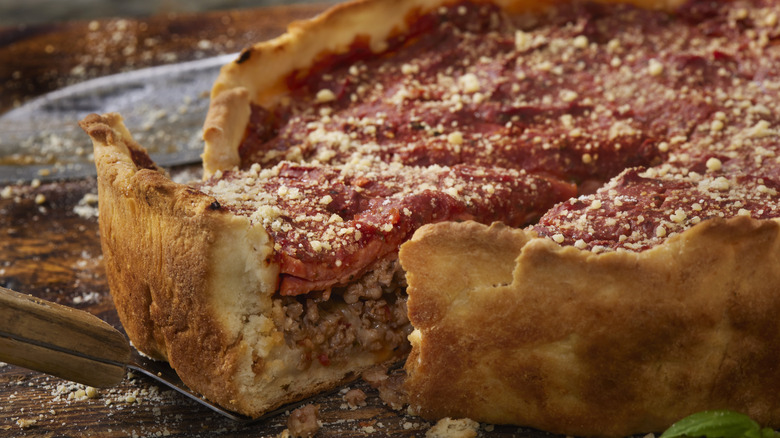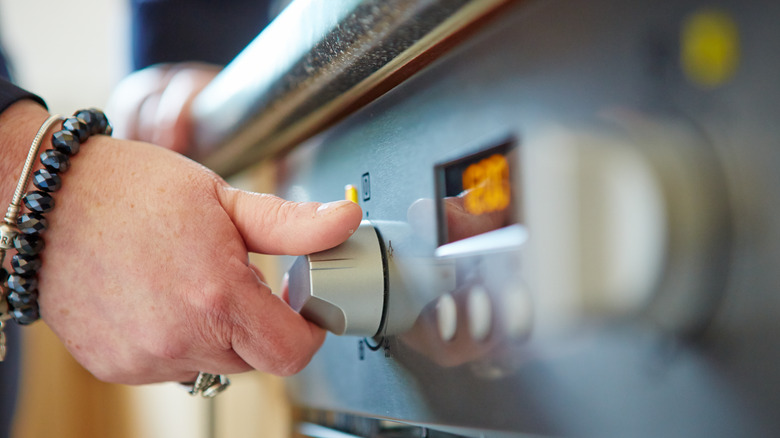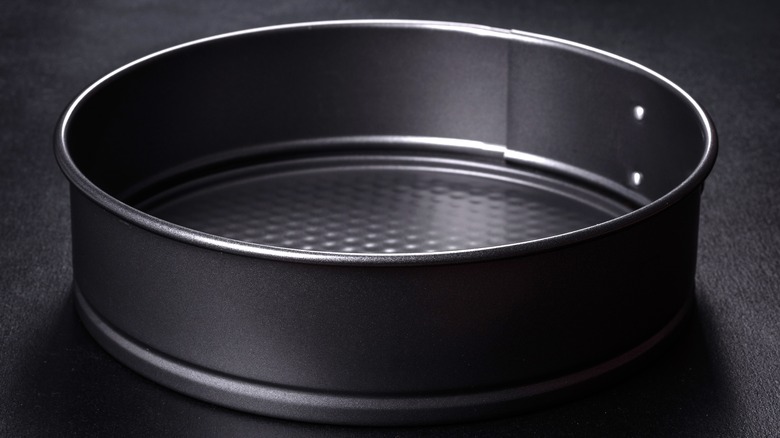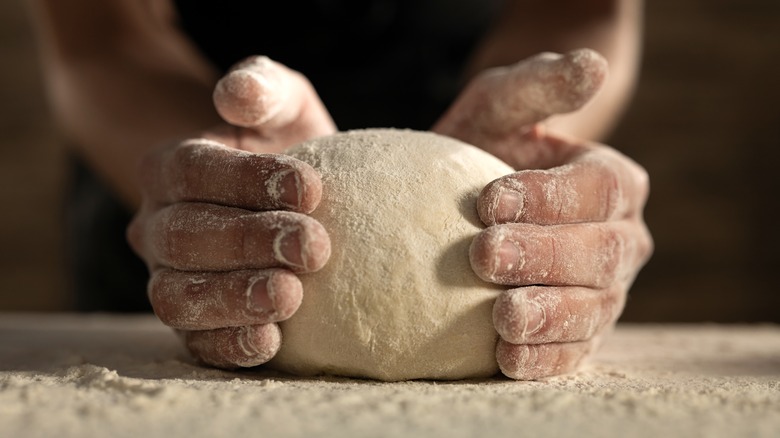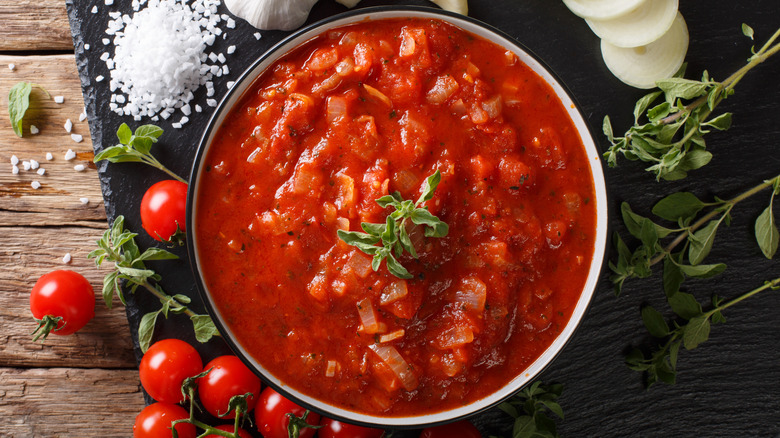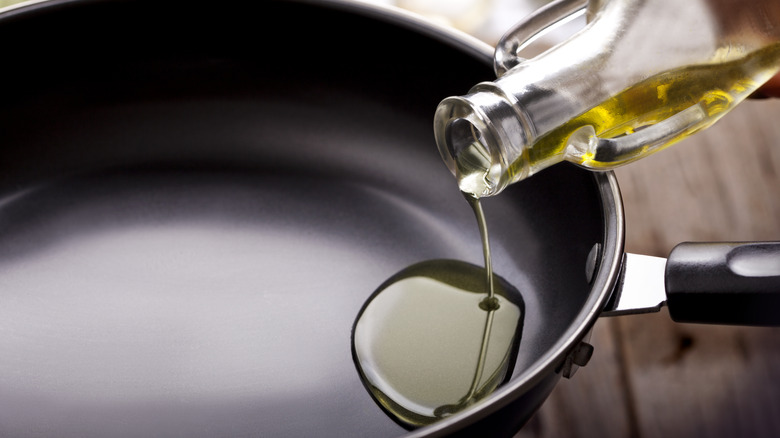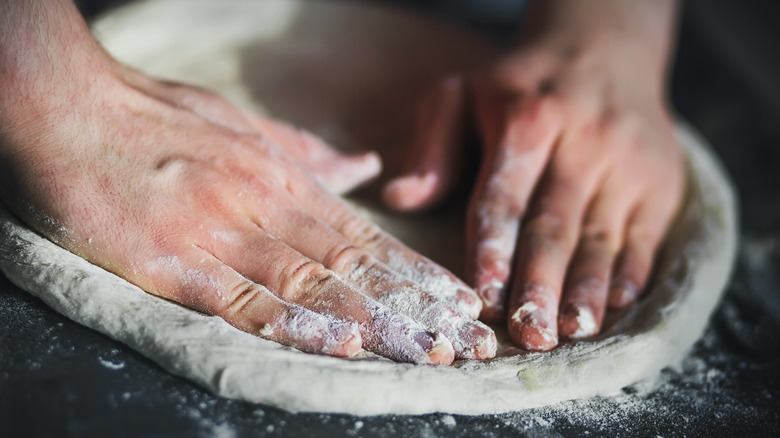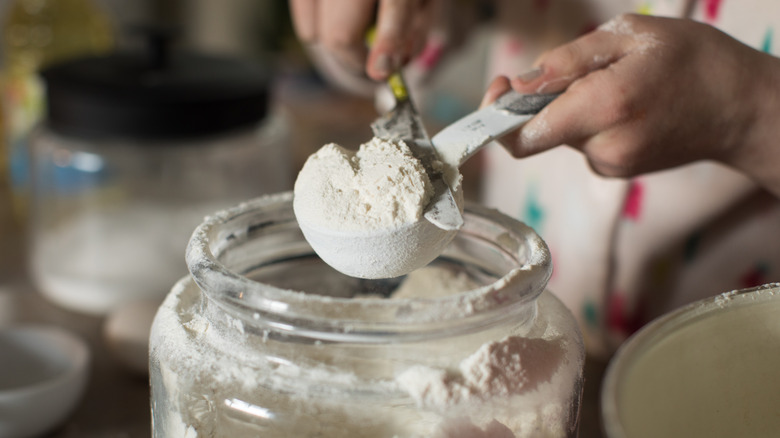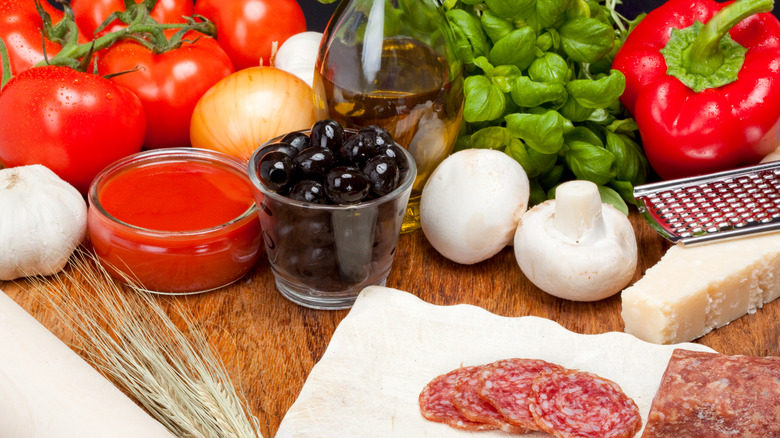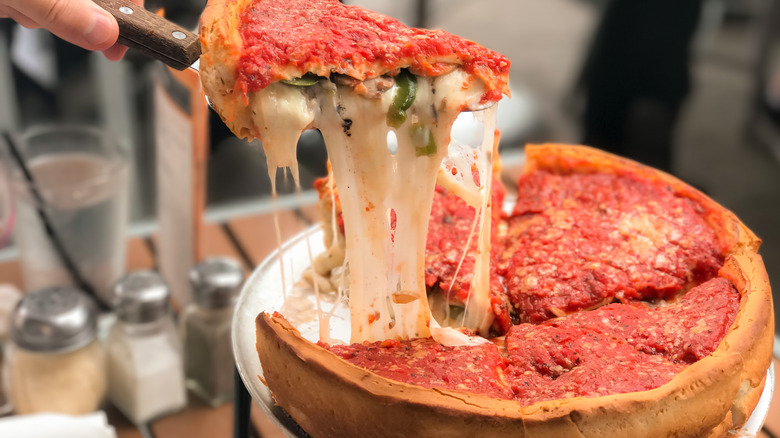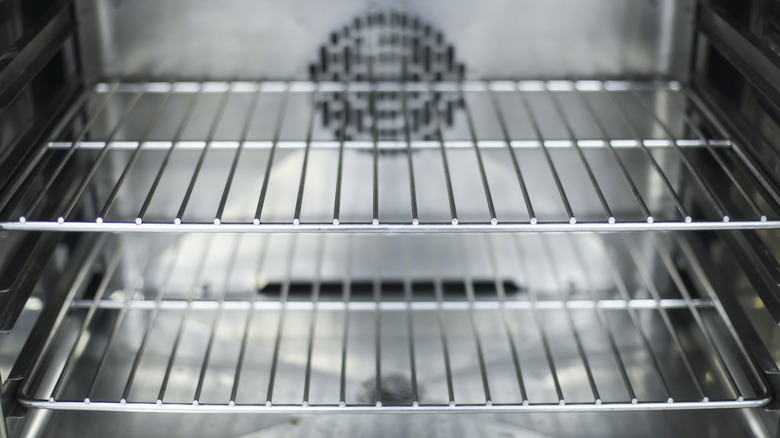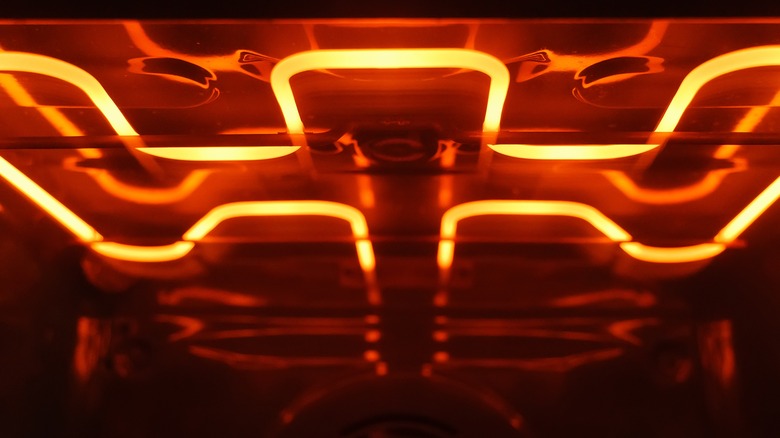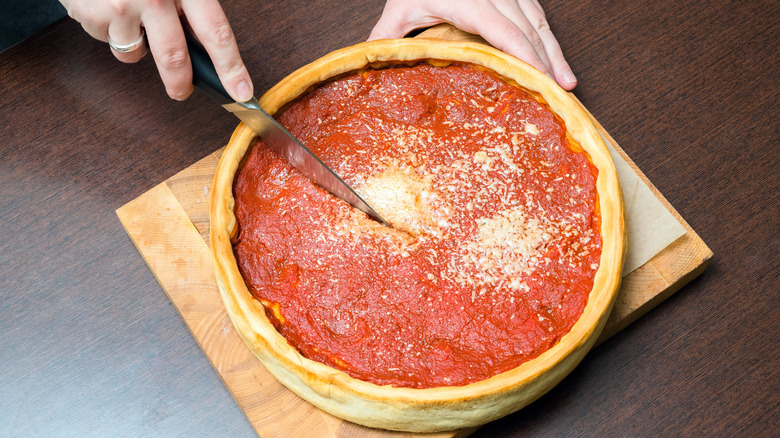12 Tips You Need When Making Deep Dish Pizza At Home
Named for its distinct cooking process and structure, deep dish pizza is loved by people worldwide. Unlike other types of pizza, its thick crust allows for an abundance of toppings and cheese, which results in a gooey, sometimes sloppy, and always delicious texture. For a unique touch, Chicago-style deep dish pizza also layers the ingredients with the sauce on top.
While the process may sound somewhat involved, making deep dish pizza at home is quite simple once you get the hang of it. But, of course, baking is a science. So one slight variation can make a massive difference in the finished result, the most common of which is a soggy or undercooked crust. That's why it's essential you pay close attention to a recipe's instructions and follow a few pro recommendations along the way. Keep reading to learn helpful tips and perfect your deep dish pizza-making skills.
Accurately preheat the oven
Preheating your oven may not be necessary with every recipe, but with deep dish pizza, it is essential. An adequately heated oven facilitates even cooking results throughout the entire pie and seriously improves dough quality regarding flavor, texture, and rising potential. The crust on deep dish pizza is considered yeast bread, which requires an immediate burst of heat for the final rising to occur. If yeast bread goes in a cooler oven, it may not rise properly. Even if the crust manages to rise, a cold oven can also result in a crumbly, dry, or dense finished product, which we definitely want to avoid when making deep dish pizza.
In addition to optimal baking results, a preheated oven helps ensure food safety throughout your pie. However, it is particularly important concerning meat. A consistent high heat enables various meat toppings to cook to the proper internal temperature, which is required to kill germs and prevent food poisoning.
Use the correct type of pan
The type of pan you use to prepare deep dish pizza can make or break the entire pie. While there are several viable options, you must use a pan with tall sides that can contain plenty of toppings plus the top layer of sauce without overflowing. In general, a deep dish sheet pan explicitly designed for making this type of pizza works best because it has high sides, comes in a range of sizes, and gets hot enough to crisp the crust.
A cast iron pan also works nicely with deep dish pizza because it gets super hot, resulting in a crispier crust on the bottom and sides. If you're having issues with soggy crust, a cast iron pan may be the solution. Considering how versatile cast iron pans are, there's also a good chance you already have one in your kitchen. Lastly, a metal pie pan, springform pan, or casserole dish can also be substituted as long as the sides are tall enough to hold your desired toppings.
Make sure you get the dough just right
To make a perfect deep dish pizza at home, you need to get the dough just right. Otherwise, it could have issues cooking all the way through, is more likely to stick to the pan, and can detract from the overall flavor. First, make sure to use a dough recipe specific to deep dish pizza. While basic pizza dough is tasty, deep dish pizza is constructed with enriched dough. It contains cornmeal and a source of fat like olive oil or butter. The addition of these ingredients allows the dough to withstand the extra weight from plentiful toppings, enhances the overall flavor, and helps maintain perfect texture throughout.
Ideally, deep dish pizza crust should be thick and doughy with a light and fluffy texture. Giving the dough a couple of hours to rise, possibly more than once, is also crucial to achieving the right consistency. If you try to skimp on prep time, you'll definitely notice a difference after baking.
Thicker sauce is preferred
For authentic Chicago-style deep dish pizza, a thicker sauce is strongly recommended. Thicker sauces help cut down on the mess by a noticeable amount. Topping your pie with a denser sauce also improves crust consistency because they have less liquid and reduce unwanted sogginess. The other ingredients already contain plenty of moisture, so minimizing it in the sauce makes a big difference. When creating a sauce from scratch, cut the ingredients in a more rustic fashion and cook until thick and hearty.
Fortunately, you can also easily thicken a smoother pre-made or store-bought sauce to the desired consistency on your stove. You'll want to gently heat sauce in a pan until it reduces and reaches the desired consistency. The slow heat encourages excess water to evaporate. In addition, the gradual reduction allows the natural sugars to release and reach their maximum flavor potential — keep in mind this could take two or more hours.
Coat the pan with plenty of oil
In addition to soggy crust, another common deep dish pizza complication involves sticking to the pan after baking, even if you use a non-stick pan. Fortunately, both of these issues can be addressed by generously greasing the pan.
To significantly improve your chances of perfection, simply apply a plentiful amount of oil to the base of the pan before pressing the dough in. Like, way more than you might use with other recipes. You want to ensure your pan's entire bottom and sides are thoroughly coated — and don't forget the crevices. A thick coating ensures the crust gets nice and crispy and makes removing the pizza from the pan much more manageable.
For added flavor, you can also try substituting butter for oil. It also crisps up in expert fashion and adds a rich taste. Just keep in mind that you'll need to soften the butter first to get an even coating. Additionally, if your recipe calls for butter in the dough, you don't want to overdo it, so oil may be a better option.
Pre-bake the dough to prevent a soggy bottom
Due to the added thickness and density of deep dish pizza crust, a quick pre-bake can make a significant difference when it comes to texture. Pre-baking deep dish crust is an easy way to facilitate added crunch and reduce the chance of winding up with the dreaded soggy bottom. Not only does this simple step help make the crust firmer, but it ensures it won't fall apart under the added weight and moisture of the many toppings layered above.
Just like with a pie crust, baking the dough before you layer it with toppings gives it a much-needed head start. A nice pre-bake also prevents overcooking the other ingredients, leading to a more pronounced flavor. You could pre-bake the crust at 425 degrees Fahrenheit for 10 minutes. Conveniently, this can easily be done while you prep your toppings and cheese, so it shouldn't add extra time to the process.
Precisely measure ingredients
Often, issues with pizza dough are caused by improperly measuring the ingredients. All it takes is for one component to be slightly off, and the crust will suffer in texture, taste, and density.
Yeast is incredibly picky and needs the ideal conditions to work and produce optimal flavor. When there's not enough liquid, yeast won't activate. If there's too much yeast, your dough will ferment too quickly, reducing taste. Adversely, when there's not enough yeast, your pizza dough will likely be dense, flat, and lack flavor. Yeast isn't the only variable. Too much flour can also lead to a dry and stiff dough.
Considering the importance of exact measurements and the wide margin for error, many chefs recommend using a scale to measure yeast and other ingredients because they are significantly more accurate than measuring by volume. Even if you don't use a scale, take the time to make precise measurements, and you'll notice a massive difference in the quality of your dough and pizza crust.
Use premium quality ingredients
Making deep dish pizza with fresh, premium ingredients leads to enhanced flavor and the best, most authentic taste. According to Fresh Ideas, the further a food travels, the higher the chance it contains needless chemicals. While these chemicals increase shelf life, they can diminish the flavor of your pizza.
Processed foods contain an abundance of sugar, sodium, and other preservatives which decrease their true taste. Canned foods also use a boiling sterilization process that further reduces their natural flavor. With this in mind, it's no surprise fresh ingredients have significantly more flavor than frozen or canned foods. Many meat pizza toppings are processed, like sausage and pepperoni, so they're going to have some additives. Even so, high-quality meats tend to have better seasonings and flavor than lower-priced options.
Whether you're adding ham, pepperoni, peppers, or basil to your deep dish pizza, always choose fresh vegetables and top-quality meats to guarantee it is bursting with rich flavor. Use local produce and meat when possible because it is less likely to have flavor-dampening additives like a wax coating, antibiotics, or hormones.
Don't be shy with the cheese
A classic trait of deep dish pizza is its stringy, melted cheese. It's no surprise that the cheese should stretch out when you extract a slice. Otherwise, it's just not Chicago deep dish pizza. Therefore, you'll want to use plenty of cheese to nail this defining characteristic. You'll also want to use the right kind of cheese. Mozzarella is one of the best cheeses for achieving the desired stringy effect because it has a good fat content for melting and bubbling. However, provolone or a blend with parmesan also works exceptionally well.
Using ample cheese is key to creating the perfect deep dish pizza, so don't use it sparingly. Considering all the other toppings you probably layered up on your pie, why be conservative with the cheese? Pile it on and create an even layer beneath the sauce; you won't regret it when you pull out a perfectly melted, stringy pizza! Yummy!
Cook in the center of the oven for even results
Positioning your pizza in the center of the oven is one of the best and easiest ways to achieve even cooking results throughout. This is because the center of the oven maintains the most consistent temperature. As a result, placing your pizza in the middle leads to more uniform baking and reduces the chances of overly browning or burning the crust.
Oven interiors fluctuate in temperature from one spot to the next, even after preheating. While many ovens have hot spots, the top, sides, and bottom are generally the hottest areas. Not only does hot air rise, which explains the top being warmer, but the metal walls on the side and bottom also increase air temperature slightly. Positioning your pizza close to one of the hotter spots can easily result in the crust browning before the rest of the pie is heated through.
In addition to center positioning, King Arthur Baking advises rotating your pan 180 degrees halfway through cooking to ensure even results. If you're cooking two pans at a time, place them on separate racks, one above the other instead of side by side. Then, midway through baking, rotate the pans from front to back and top to bottom.
High heat is best
To form the perfect crust, you'll need to bake your deep dish pizza at a high temperature to cook through the layers of ingredients and dough properly. Otherwise, you could wind up with cold spots in the center, improperly cooked ingredients, or a soggy crust.
In general, deep dish pizza recipes recommend baking between 400 and 500 degrees Fahrenheit. We recommend staying on the higher end of this, especially if your pie has an abundance of toppings. You may be able to get away with a lower temperature if your pizza isn't loaded with ingredients, but higher is still better. Fortunately, unless you forget about your pie, it's hard to burn a deep dish pizza, so go ahead and turn up the heat.
The only issue you may encounter with high heat is the edges brown too quickly. If this happens, simply place foil over the top in a tented position to prevent burning, just like you would with a pot pie. If you are a little unsure about whether your deep dish pizza is done just by looking at it, you can always use a food thermometer to double-check. As long as it's 190 degrees Fahrenheit or higher, you should be good to go.
Lastly, if you're still having trouble achieving the right crust consistency, try placing a pizza stone under your deep dish pan to ensure you achieve the heat needed for a crispy base layer.
Let the pie cool before cutting
Just like with other types of pizza, it is essential you give deep dish pizza time to cool before slicing and enjoying. Even a perfectly cooked pie can fall apart at the very end if you try to cut and serve it straight out of the oven. Due to all the layers, giving a deep dish pizza time to rest is especially important if you want it to stay intact, which of course, you do.
To ensure your pizza doesn't turn into a runny mess, let it sit for approximately five to 10 minutes before cutting. This should give it enough time to properly cool for cutting while still remaining hot enough to enjoy. In addition, when the time comes to finally cut your pizza, use a chef's knife instead of a rolling pizza cutter. Pizza cutters apply a lot of pressure to a small space, which can cause deep dish pizzas to crumble. Using a knife will make it easier to cut and serve.

